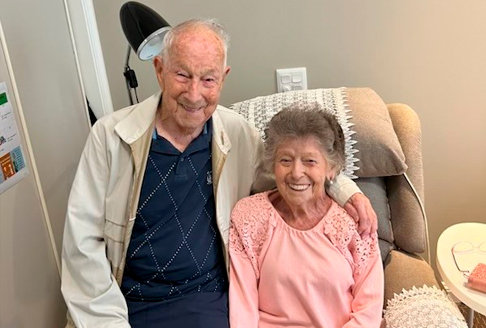The story of Jack and Gloria begins in the popular seaside town of Inverloch, on the Gippsland coast. Six-year-old Gloria had moved from Woodend to join Jack’s Inverloch Primary school. Jack remembers Gloria as ‘the new kid on the block,’ a ‘pretty young thing from out of town.’
“I recall all the boys being sweet on Gloria,” said Jack “so I thought I better pull out all the stops to get her attention! I used to pinch roses out of the gardens on my way to school just to sweeten the deal!”’
Jack recalls Friday morning singing where the older children had to sing a solo, but Gloria refused, resulting in the whole school being keep in for lunch until Gloria eventually – through tears – managed to belt out a song.
Jack and Gloria were students at the same school until about year eight when Jack left school to work at a grocery shop in Inverloch and Gloria moved to Yallourn North to work in a women’s clothing store. Later on, Jack joined the Navy and lost contact with Gloria. It wasn’t until years later when Jack moved to Morwell that he would see Gloria around town, but both had married by then and had their own families.
“Jack was always well behaved and well mannered, he never put a foot wrong and was always doing what he was told. Nothing like the show pony you see today!”
Gloria remembers Jack as the shy boy who brought her roses that she kept in a silk box.
Jack and Gloria joke about Jack being her first boyfriend – the one she couldn’t forget. In fact, Gloria’s first husband’s name was Jack and then Gloria later remarried and – you guessed it – his name was also Jack! They joke that she tried to replace Jack with another Jack and another Jack.
Office Manager at St Hilary’s Shylo Murphy remembers the day that Gloria and Jack saw each other again for the first time in years at St Hilary’s. “I remember hearing Jack saying, “oh my goodness – is that Gloria?” and Gloria turning towards him, stopping still and saying ‘Oh, who let you in here?!’ with the cheekiest smile on her face!” said Shylo. “Both were like teenagers again for a split second, you could see both just as nervous as the other one.”
As the chat draws to an end, Jack turns to Gloria with his trademark playful grin and says, “You will always be the sweet girl with her hair in curls to me.”
Rumour has it that Jack still remembers Gloria’s birthday and has even pre-ordered the roses, and that Gloria just may have the perfect silk box ready and waiting.
With thanks to Shylo Murphy, Office Manager at St Hilary’s for her interview notes.
Community news
-

Back to School Tips for Foster and Kinship Carers
Heading back to school can be exciting, but it can also bring up big feelings—especially for kids in care. Here are a few simple ways to help make the transition smoother.
- 17 Apr 2025
-

Easter Reflection from Emily Booth of our Spiritual Care Team
A few years ago, at Easter, I was staying with my sister and her family for the weekend. One afternoon we were all sitting around chatting and the kids were playing when my sister came into the room and placed a tray of fresh, warm hot cross buns on the table
- 16 Apr 2025
-

Student Volunteer Spotlight - Erin
Did you know that Baptcare has student volunteers at some of our Residential Aged Care communities? Our volunteers are an integral part of our Baptcare community, not only in residential aged care but across many of our programs and services. Volunteers provide essential connection, positivity and assistance to residents, clients and consumers.
- 04 Apr 2025

